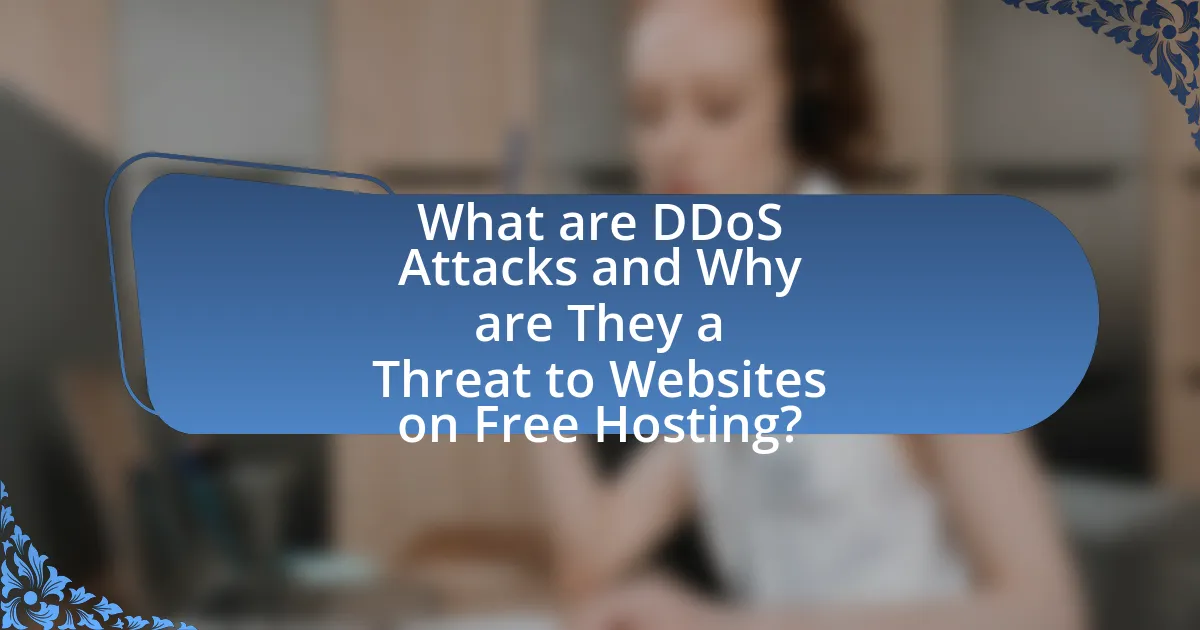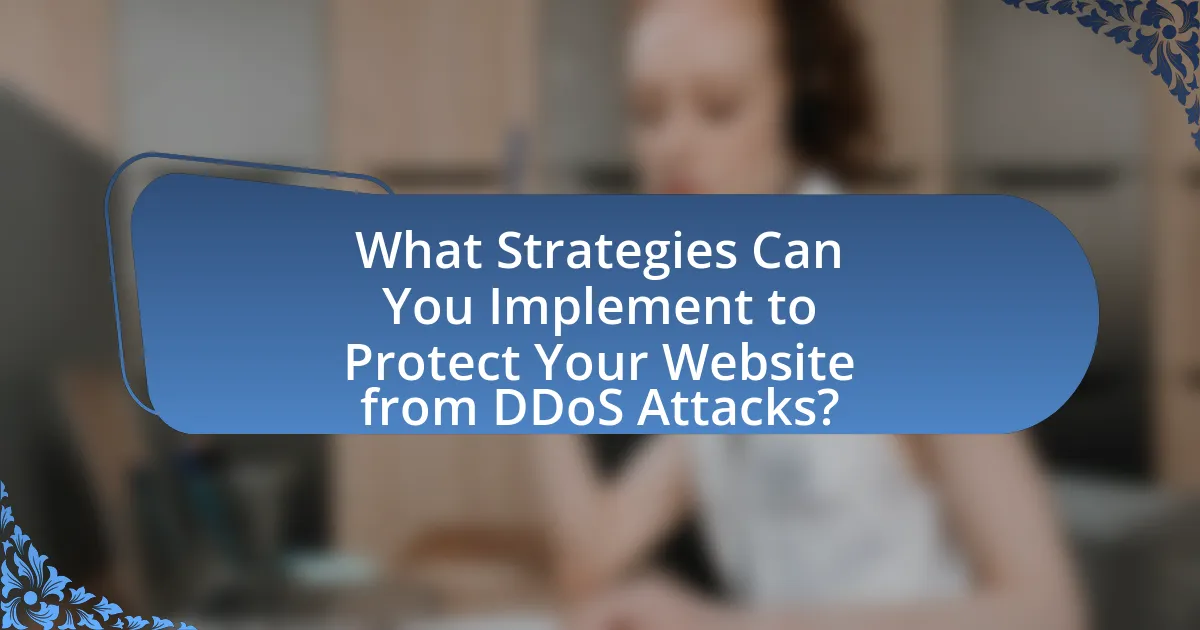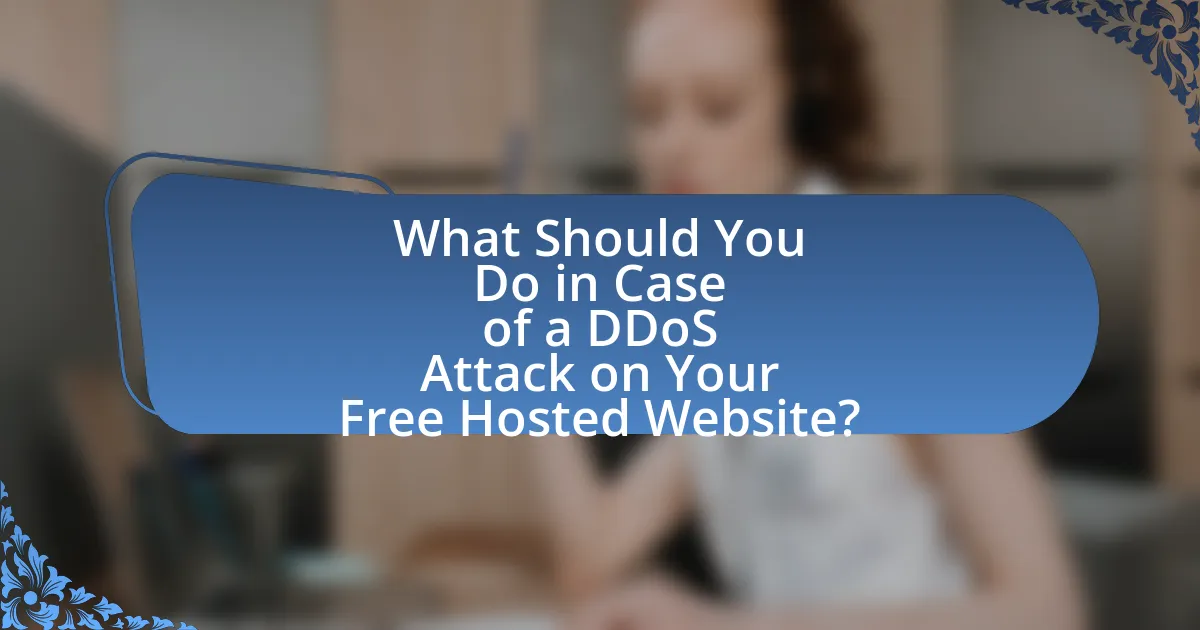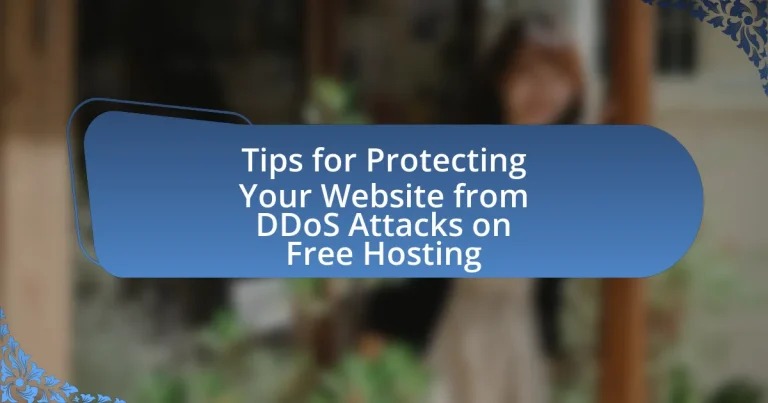DDoS attacks, or Distributed Denial of Service attacks, are significant threats to websites hosted on free platforms due to their limited security measures and resources. This article outlines the mechanics of DDoS attacks, the various types, and the motivations behind them, emphasizing the vulnerabilities of free hosting services. It provides practical strategies for protecting websites, including the use of Content Delivery Networks (CDNs), rate limiting, and security plugins. Additionally, it discusses how to identify and respond to DDoS attacks, as well as long-term strategies for enhancing website resilience against future threats.

What are DDoS Attacks and Why are They a Threat to Websites on Free Hosting?
DDoS attacks, or Distributed Denial of Service attacks, are malicious attempts to disrupt the normal functioning of a targeted server, service, or network by overwhelming it with a flood of internet traffic. These attacks pose a significant threat to websites on free hosting because such services often lack robust security measures and resources to mitigate large-scale traffic surges. For instance, a study by the cybersecurity firm Akamai reported that 91% of DDoS attacks target organizations with limited resources, making free hosting platforms particularly vulnerable. The limited bandwidth and processing power of free hosting services can lead to complete service outages during a DDoS attack, resulting in loss of accessibility and potential damage to the website’s reputation.
How do DDoS attacks work?
DDoS attacks work by overwhelming a target server, service, or network with a flood of internet traffic, rendering it unable to respond to legitimate requests. Attackers typically use a network of compromised devices, known as a botnet, to generate massive amounts of traffic directed at the target. For instance, in 2018, a DDoS attack on GitHub peaked at 1.35 terabits per second, demonstrating the potential scale and impact of such attacks. This influx of traffic can exhaust the target’s resources, leading to downtime or degraded performance, which is the primary goal of the attackers.
What types of DDoS attacks exist?
There are several types of DDoS attacks, including volumetric attacks, protocol attacks, and application layer attacks. Volumetric attacks, such as UDP floods and ICMP floods, aim to overwhelm the bandwidth of the target by sending a massive amount of traffic. Protocol attacks, like SYN floods and Ping of Death, exploit weaknesses in network protocols to disrupt services. Application layer attacks, such as HTTP floods, target specific applications to exhaust server resources. Each type of DDoS attack has distinct characteristics and methods of execution, making them effective against different aspects of network infrastructure.
What are the common motivations behind DDoS attacks?
Common motivations behind DDoS attacks include financial gain, political activism, personal vendettas, and competitive advantage. Attackers often seek to extort money from organizations by threatening service disruption unless a ransom is paid. Political activists may use DDoS attacks to protest against entities they oppose, aiming to disrupt their operations and draw attention to their cause. Personal vendettas can drive individuals to target specific websites or services to settle scores. Additionally, businesses may engage in DDoS attacks against competitors to hinder their online presence and gain market share. According to a report by the cybersecurity firm Akamai, 43% of DDoS attacks are motivated by financial gain, highlighting the prevalence of this motivation in the threat landscape.
Why are free hosting services particularly vulnerable to DDoS attacks?
Free hosting services are particularly vulnerable to DDoS attacks because they often lack robust security measures and resources to mitigate such threats. These services typically operate on shared infrastructure, making it easier for attackers to overwhelm multiple sites simultaneously. Additionally, free hosting providers may not prioritize security investments, leaving their systems exposed to exploitation. According to a report by Cloudflare, free hosting platforms are frequently targeted due to their limited bandwidth and lack of advanced DDoS protection, which can lead to significant downtime and service disruption for users.
What limitations do free hosting services have that increase vulnerability?
Free hosting services often have limitations such as lack of security features, limited bandwidth, and shared resources, which increase vulnerability to attacks. These services typically do not provide robust security measures like firewalls or DDoS protection, making websites more susceptible to malicious activities. Additionally, the shared nature of free hosting means that if one site on the server is compromised, others can be affected, leading to increased risk. Furthermore, limited bandwidth can result in slower response times during an attack, exacerbating the impact of DDoS incidents.
How does the lack of resources in free hosting affect DDoS mitigation?
The lack of resources in free hosting significantly hinders effective DDoS mitigation. Free hosting services typically offer limited bandwidth, processing power, and security features, making them more vulnerable to DDoS attacks. For instance, when a DDoS attack occurs, the insufficient resources cannot handle the influx of malicious traffic, leading to service downtime or complete unavailability. Additionally, many free hosting providers lack advanced security measures, such as traffic filtering and rate limiting, which are essential for mitigating DDoS threats. This combination of limited resources and inadequate security capabilities results in a higher likelihood of disruption during an attack.

What Strategies Can You Implement to Protect Your Website from DDoS Attacks?
To protect your website from DDoS attacks, implement strategies such as using a content delivery network (CDN), employing rate limiting, and utilizing DDoS protection services. A CDN distributes traffic across multiple servers, reducing the impact of an attack by absorbing excess traffic. Rate limiting controls the number of requests a user can make in a given timeframe, preventing overload. DDoS protection services, like Cloudflare or Akamai, offer specialized tools to detect and mitigate attacks in real-time. According to a report by the cybersecurity firm Radware, organizations using these strategies can reduce the risk of downtime by up to 80%.
How can you enhance your website’s security against DDoS attacks?
To enhance your website’s security against DDoS attacks, implement a combination of traffic filtering, rate limiting, and using a Content Delivery Network (CDN). Traffic filtering allows you to identify and block malicious traffic before it reaches your server, while rate limiting restricts the number of requests a user can make in a given timeframe, effectively mitigating the impact of an attack. Utilizing a CDN distributes your website’s content across multiple servers, which can absorb and mitigate traffic spikes caused by DDoS attacks. According to a report by Cloudflare, websites using CDNs experienced a 60% reduction in downtime during DDoS attacks, demonstrating the effectiveness of these strategies in enhancing security.
What role does a Content Delivery Network (CDN) play in protection?
A Content Delivery Network (CDN) plays a crucial role in protection against DDoS attacks by distributing traffic across multiple servers, thereby mitigating the impact of overwhelming traffic directed at a single point. CDNs absorb and disperse malicious traffic, which helps maintain website availability and performance during an attack. For instance, Akamai, a leading CDN provider, reported that their network can handle over 100 terabits per second of traffic, significantly reducing the risk of downtime during DDoS incidents. This capability allows websites to remain operational even under heavy attack, demonstrating the effectiveness of CDNs in enhancing website security.
How can rate limiting help mitigate DDoS attacks?
Rate limiting can help mitigate DDoS attacks by controlling the number of requests a user can make to a server within a specified timeframe. This mechanism reduces the impact of overwhelming traffic by ensuring that legitimate users can still access the service while blocking or throttling excessive requests from malicious sources. For instance, implementing a rate limit of 100 requests per minute can prevent a single IP address from flooding the server with requests, thereby maintaining service availability. Studies have shown that effective rate limiting can decrease the success rate of DDoS attacks significantly, as it limits the attacker’s ability to exhaust server resources.
What are the best practices for configuring your website on free hosting?
The best practices for configuring your website on free hosting include using a Content Delivery Network (CDN) to distribute traffic, implementing rate limiting to control the number of requests from a single IP address, and regularly updating your website’s software to patch vulnerabilities. Utilizing a CDN can help absorb traffic spikes during a DDoS attack, as it spreads the load across multiple servers. Rate limiting prevents any single user from overwhelming your server, thus maintaining performance. Keeping software updated is crucial because outdated systems are more susceptible to exploitation, which can be a target during DDoS attacks. These practices collectively enhance your website’s resilience against potential threats while using free hosting services.
How can you optimize your website’s performance to withstand attacks?
To optimize your website’s performance to withstand attacks, implement a Content Delivery Network (CDN) to distribute traffic and reduce server load. CDNs cache content across multiple servers globally, which not only speeds up access for users but also mitigates the impact of Distributed Denial of Service (DDoS) attacks by absorbing excess traffic. According to a report by Cloudflare, using a CDN can reduce the load on the origin server by up to 70%, significantly enhancing resilience against attacks. Additionally, employing rate limiting can restrict the number of requests a user can make in a given timeframe, further protecting your site from potential overload during an attack.
What security plugins or tools can you use on free hosting platforms?
Security plugins and tools that can be used on free hosting platforms include Cloudflare, Sucuri, and Wordfence. Cloudflare provides a free tier that offers DDoS protection and a web application firewall, which helps mitigate attacks. Sucuri offers a free security scanner that can identify vulnerabilities, while Wordfence provides a free version that includes firewall protection and malware scanning for WordPress sites. These tools are effective in enhancing security on free hosting platforms, which often lack robust built-in security measures.

What Should You Do in Case of a DDoS Attack on Your Free Hosted Website?
In case of a DDoS attack on your free hosted website, immediately contact your hosting provider for assistance. Hosting providers often have measures in place to mitigate DDoS attacks, such as traffic filtering and rate limiting. Additionally, you should monitor your website’s traffic to identify unusual patterns and consider implementing a Content Delivery Network (CDN) that offers DDoS protection. According to a report by Cloudflare, 70% of organizations that use a CDN experience improved performance and security against DDoS attacks.
How can you identify if your website is under a DDoS attack?
You can identify if your website is under a DDoS attack by monitoring for sudden spikes in traffic, unusual patterns of requests, and significant slowdowns or outages. These indicators suggest that your server is overwhelmed by excessive requests, which is characteristic of DDoS attacks. For instance, a legitimate website typically experiences consistent traffic patterns, while a DDoS attack may cause traffic to surge unexpectedly, often from multiple IP addresses. Additionally, tools like web analytics can help track these anomalies, confirming the presence of a potential attack.
What signs indicate a DDoS attack is occurring?
Signs indicating a DDoS attack is occurring include a sudden spike in traffic, unusually slow network performance, and intermittent service outages. These symptoms often manifest when multiple compromised systems flood a target with excessive requests, overwhelming its resources. For instance, a report by the Cybersecurity and Infrastructure Security Agency (CISA) highlights that a significant increase in traffic from various IP addresses can signal a DDoS attack, as legitimate users experience degraded service or inability to access the website.
How can you monitor your website’s traffic for unusual patterns?
To monitor your website’s traffic for unusual patterns, utilize web analytics tools such as Google Analytics or specialized monitoring services like Cloudflare. These tools provide real-time data on visitor behavior, traffic sources, and anomalies in traffic volume. For instance, Google Analytics can alert you to sudden spikes in traffic, which may indicate a DDoS attack, as it tracks user sessions and page views. Additionally, setting up custom alerts for unusual traffic patterns, such as a sudden increase in requests from a single IP address, can help identify potential threats.
What immediate actions should you take during a DDoS attack?
During a DDoS attack, the immediate actions to take include activating your DDoS mitigation service, notifying your hosting provider, and implementing rate limiting on your server. Activating a DDoS mitigation service can help filter out malicious traffic, while notifying your hosting provider allows them to assist in managing the attack. Implementing rate limiting restricts the number of requests a user can make, which can help maintain service availability. These actions are critical as they directly address the influx of harmful traffic and help maintain operational integrity during an attack.
How can you temporarily disable certain features to reduce load?
To temporarily disable certain features and reduce load, website administrators can turn off non-essential functionalities such as plugins, animations, or heavy scripts. This action minimizes resource consumption, allowing the server to allocate more bandwidth and processing power to critical operations. For instance, disabling image sliders or comment sections can significantly decrease the load on the server during high traffic periods, particularly during DDoS attacks, where resource strain is exacerbated. Studies show that reducing the number of active features can lead to a 30-50% decrease in server load, enhancing overall site performance and stability.
What steps can you take to contact your hosting provider for assistance?
To contact your hosting provider for assistance, first locate their official support page, which typically includes contact options such as live chat, email, or phone support. Next, choose the most appropriate method based on your urgency and preference; for immediate issues, live chat or phone support is often the fastest. If your issue is less urgent, sending an email may suffice. Additionally, gather relevant information about your account and the specific issue you are facing to facilitate a quicker resolution. Many hosting providers also offer a knowledge base or FAQ section that can provide immediate answers to common questions.
What long-term strategies can help prevent future DDoS attacks?
Implementing a multi-layered security approach is a long-term strategy that can significantly reduce the risk of future DDoS attacks. This includes utilizing advanced firewalls, intrusion detection systems, and rate limiting to filter out malicious traffic. According to a report by the Cybersecurity and Infrastructure Security Agency (CISA), organizations that adopt such comprehensive security measures can mitigate the impact of DDoS attacks by up to 80%. Additionally, regularly updating software and infrastructure ensures vulnerabilities are patched, further decreasing the likelihood of successful attacks.
How can regular security audits improve your website’s resilience?
Regular security audits enhance a website’s resilience by identifying vulnerabilities and weaknesses that could be exploited during a DDoS attack. These audits systematically assess the website’s security posture, ensuring that potential entry points for attackers are addressed. For instance, a study by the Ponemon Institute found that organizations conducting regular security assessments experienced 50% fewer successful breaches compared to those that did not. By proactively identifying and mitigating risks, security audits help fortify defenses, making it more difficult for attackers to disrupt services and maintain website availability during high-traffic events.
What role does user education play in preventing DDoS attacks?
User education plays a crucial role in preventing DDoS attacks by equipping individuals with the knowledge to recognize and mitigate potential threats. Educated users can identify suspicious activities, such as unusual traffic patterns or phishing attempts, which are often precursors to DDoS attacks. According to a report by the Cybersecurity and Infrastructure Security Agency (CISA), organizations that implement user training programs see a significant reduction in security incidents, including DDoS attacks, as informed users are less likely to fall victim to tactics that exploit human error.
What are the most effective tips for protecting your website from DDoS attacks on free hosting?
To effectively protect your website from DDoS attacks on free hosting, implement a combination of traffic filtering, rate limiting, and using a Content Delivery Network (CDN). Traffic filtering allows you to block malicious requests before they reach your server, while rate limiting restricts the number of requests a user can make in a given timeframe, reducing the impact of an attack. Utilizing a CDN can distribute traffic across multiple servers, absorbing excess load during an attack. According to a report by Cloudflare, websites using CDNs experienced a 70% reduction in downtime during DDoS attacks, demonstrating the effectiveness of these strategies.


